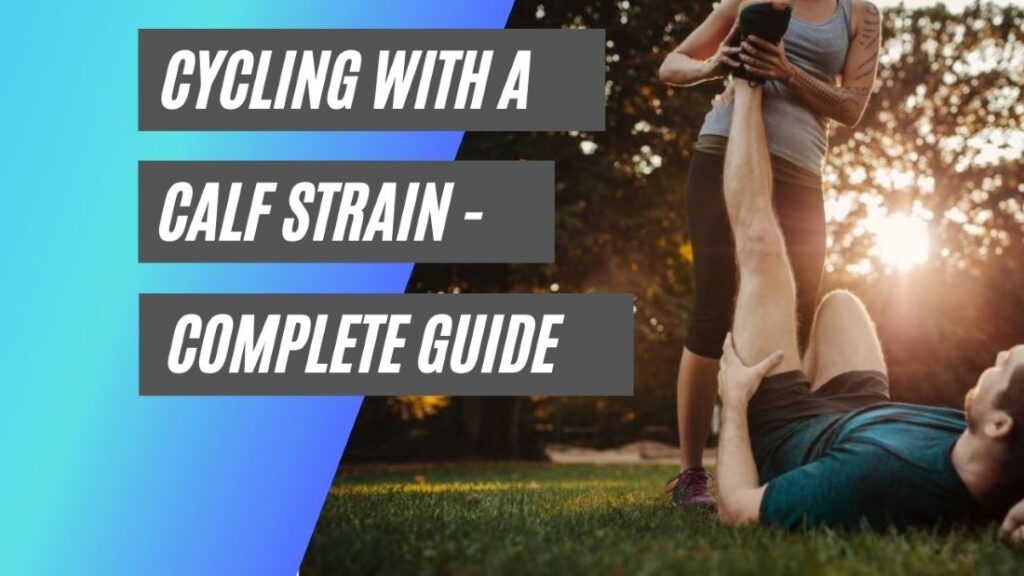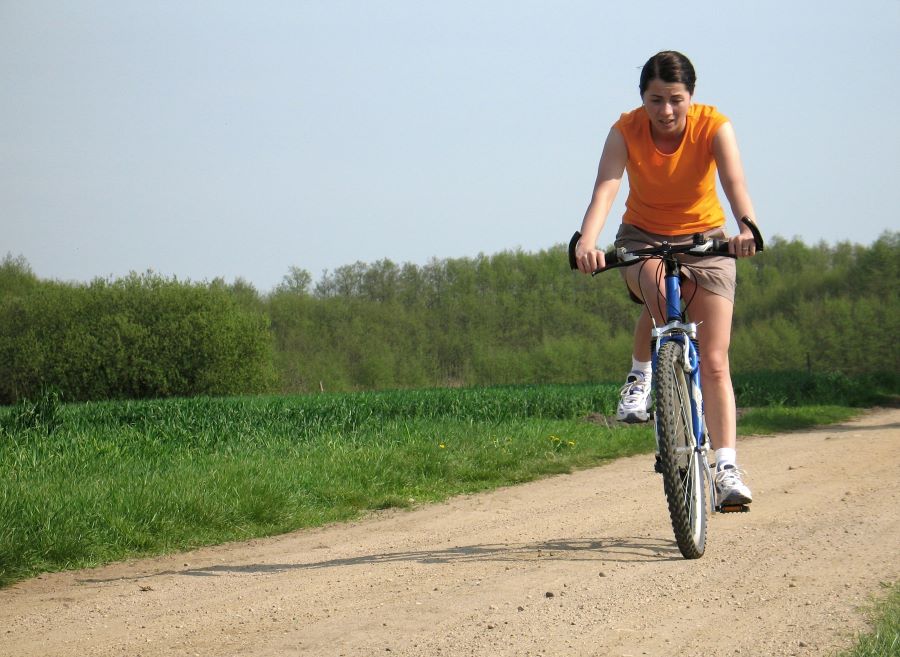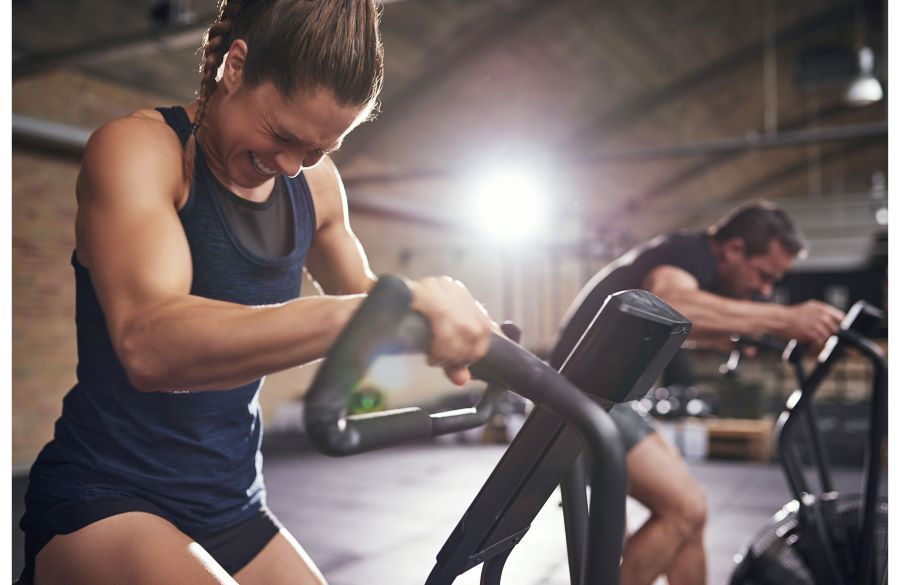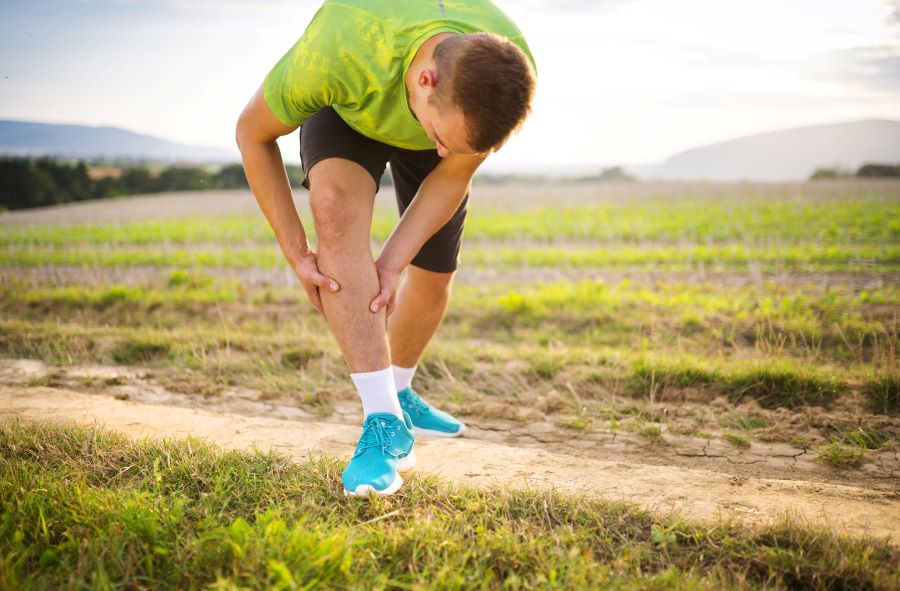This post may contain affiliate links. If you click an affiliate link and make a purchase, I may earn a commission. Also, as an Amazon Associate, I earn from qualifying purchases.--
A calf strain manages to be both painful and annoying in equal measure. It can hurt, but sometimes not as much as other strains, and yet it has this amazing ability to restrict your movement in so many ways.
But here’s the big question for us cycling nuts – can you cycle with a calf strain?
You should not cycle with a calf strain, as this can antagonize the injury, and lead to a much longer period off your bike than if you rested. The medical solution to a calf strain is relatively simple – rest, ice, and patience.
Of course, there are different levels of calf strains and different stages of injury.
In this post, I’m going to go through when you can get back on your bike during the healing process, how long the healing process takes, how to get back on your bike successfully, and much more…

Can You Cycle with a Calf Strain?
But first, let’s clear up the key question which is whether you can continue to cycle with a calf strain?
Well, the answer is a resounding no. If you do indeed develop a calf strain, then stop cycling as soon as you can.
Failing to stop will only make matters worse. Not only will it mean the injury can develop into something more severe, but it will also hamper your recovery time.
Basically, if you try to ‘push through’ a strain thinking you can somehow shake it off, then you are in for a surprise. Instead of being off your bike for a short period of time to recover, it’s very easy to actually be off your bike for weeks at a time if you fail to manage the issue correctly.
How to Know You Have a Calf Strain
But how do you even know when you have a calf strain? Well, you have several key symptoms you need to be looking out for.
First, you may find it difficult to tense your calf muscle, or even stand on your toes. When standing on your toes, you put a lot of pressure through the calf muscle, and when it’s strained it just cannot cope with that pressure.
This will also include feeling some pain in the calf muscle area. You could also find it difficult to bend at the knees as this too puts pressure on the calf muscle which is already very irritated and inflamed.
There may also be some swelling in the area of your calf muscle. It’s sore to touch, and walking or cycling becomes exceptionally difficult. [Source]
Basically, it’s very easy to spot, and that does at least give you the opportunity to go ahead and treat it in the right way.
How to Treat a Calf Strain
Keep in mind that a calf strain means the muscle is inflamed and under too much stress. Also, a strain can lead to a number of small or partial tears occurring in the muscle. If that happens, then you will be looking at a longer period of time off your bike.
But treating it is relatively basic. Patience, rest, and ice will be the key components in your recovery, and each one is as important as the others.
You really need to take as much weight off your leg as quickly as possible. Walking, or continuing to cycle, is not an option. The muscle needs time to recover and to settle down from the strain that has been placed on it. [Source]
It can also be beneficial to wear some sort of compression aid. An elasticated bandage over your calf muscle can make a huge difference, as it gives support and prevents the muscle from moving quite so much.
At the same time, you should only wear that bandage for short periods of time. Some light stretches will also be appropriate, but not in the first week or so. That will simply put too much pressure on your calf muscle when it really does not need it.
Patience, rest, and ice will be the key components in your recovery, and each one is as important as the others.

Do You Need a Walking Aid?
In severe cases, using crutches or some sort of walking aid can be beneficial to your recovery. It means you can take more weight off the damaged leg until it has had the chance to start the repair process.
Using a walking aid is often only for the most severe strains. Also, after a period of time, incorporating heel lifts in your shoes for a short while can make a difference.
By using heel lifts, it means you can take some of the pressure off the muscle. Taking some of the workload off the muscle means it has the time and ability to heal, and you will be back on your bike sooner than you know it.
How Long Does it Take to Heal?
This is where there may be a problem in that it’s difficult to know exactly how long it will take to heal.
A strain is notoriously difficult to predict in terms of how long it will take. A slight strain may be a week to 10 days, but a more severe strain can easily lead to you being off your bike for weeks.
Calf strains are often categorised into three grades – grade 1, grade 2 and grade 3.
The hss.edu website classifies the three different grades as follows: (Source)
Grade 1: Mild damage to individual muscle fibers (less than 5% of fibers) that causes minimal loss of strength and motion.
Grade 2: More extensive damage with more muscle fibers involved. However, the muscle is not completely ruptured. These injuries present with significant loss of strength and motion. These injuries may require two to three months before a complete return to athletics.
Grade 3: Complete rupture of a muscle or tendon. These can present with a palpable defect in the muscle or tendon. However, swelling in the area may make this difficult to appreciate. These injuries sometimes require surgery to reattach the damaged muscle and tendon.
Here is a simple table of the kinds of recovery times you might expect with each of the different types of strains:
| Grade of Tear | Recovery time before cycling again |
| Grade 1 | 7-10 days |
| Grade 2 | 4-6 weeks |
| Grade 3 | 12-15 weeks |
However, the key here is to assess how things are progressing on an individual basis. Remember those symptoms of a strain mentioned earlier? Well, you can use those symptoms as a guide as to how it is progressing.
If you feel less pain, then it’s a good sign as is having a greater range of movement without encountering too much difficulty.
However, there’s another problem with a calf strain to be aware of:
The problem is that a calf strain is very good at appearing to be healing only to have a setback and take you back to where you were when you first damaged the muscle. That is often due to people being impatient and not willing to wait long enough for everything to heal.
Your calf muscle is fragile when it has been strained. It takes very little in the way of excess pressure for it to become very inflamed and damaged once more.
So, please don’t rush things. It will only lead to you being off your bike for longer than you hoped.

Starting Back After a Calf Strain
So let’s jump forward in time to a point where you feel your calf is strong enough to withstand some exercise. If so, then this is what you need to do.
First, don’t just jump on your bike. Start off by having a walk.
Clearly, walking puts a different type of pressure on your calf muscle when compared to cycling. However, it can work as a good gauge as to where you are in your recovery.
You want to have a walk that is of a reasonable length and speed where you are putting some pressure through your calf muscle, but without too much stress. However, do pay close attention to what is going on. Is there any sense of your calf muscle being tight or in pain?
We would actually recommend going for several walks to see how it feels not only at the time but also after the exercise. Also, if you jog, then a light jog may also be appropriate.
Getting Back On The Bike
So the next step is to get back on your bike, but this is merely for a short recovery ride where you are effectively testing out your calf muscle without pushing yourself.
This means you are looking at a short, easy ride that should be on the flat. You don’t want to be getting up out of the saddle in order to power up an incline pushing more power and energy through your calf muscle. At this point, it’s not going to be ready for that.
Keep things short and slow. Then, pay close attention to how you care for the muscle once you get back off your bike.
It’s best to rest and ice your calf. Remember that it is still potentially fragile at this moment. However, it’s good you have managed to get the blood flowing through the muscle and you can then determine how it has stood up to that pressure and power.

Build Things Slowly
It’s important you really assess how you feel after that initial ride. If your calf muscle feels tight, then rest for a period of time before you even contemplate getting back on your bike.
The fact that a calf muscle injury can easily flare up again with little warning should be at the forefront of your mind.
You need to restrict the miles for the first few rides and do remember our other point regarding keeping things flat.
After the first few rides, you can then start to increase speed, distance, and the pressure going through your calf.
Recovery is Important
While we have talked about recovery from your calf problem, at this moment in time we are talking about recovery from the ride.
You may be used to doing very little when finishing your ride, but that’s wrong. This is the time where you will need to change things around a bit and start to take more care of your body to even stop this calf strain from happening once again.
After you have finished your ride, you need to stop your calf muscles from tensing up. That’s where some basic stretches will really come into their own.
You need to effectively ‘warm down’ after a ride. Stretching helps, and even a light massage over the muscle can make a difference.
Do not simply stop and that’s it. Doing this can cause more complications than you would imagine.
Also, when you are just starting the process of getting over a calf strain, make sure you take breaks between rides. It just means you can take a couple of days’ break between rides to give your calf muscle a chance to become less inflamed.
This is going to be annoying and stressful for any individual who loves to be on their bike a lot, but you must look at the bigger picture here. That is the only way in which you will recover correctly.
Overall Conclusion
Cycling with a calf strain is not advisable. In fact, it is highly recommended that you go nowhere near your bike whenever you have a calf strain.
It may not sound like much, but a strain can turn into a partial tear, and you are then looking at being off your bike for longer than you would like.
Rest your leg, avoid all exercise, and ice it. Be patient as you cannot afford to rush back into getting on your bike until your leg is completely ready to deal with it.
Failing to do this could lead to you causing problems with not only your calf muscle but also your knee and achilles.
Getting back on our bike will happen, but slowly. A calf strain has to be one of the most annoying injuries around. It sounds slight, and yet the result is often something that is difficult to get over with the potential to be off your bike for weeks.
But treat it correctly, and you should have no problems getting back into your training, or even cycling to work without any ill effects.
